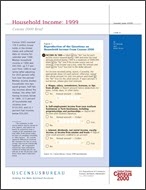Census 2000 Brief: Household Income: 1999
Census 2000 Brief: Household Income: 1999
Census 2000 counted 105.5 million households in the United States and collected data on income for calendar year 1999. Median household income in 1999 was $42,000, up 7.7 percent from 1989 in real terms (after adjusting for 29.8 percent inflation over the period).1 Median income divides households into two equal groups, half having incomes above the median, the other half having incomes below. In 1999, 12.3 percent of households had incomes over $100,000, and 22.1 percent had incomes below $20,000.
This report, part of a series that presents population and housing data collected by Census 2000, provides information on the distribution of household income. Census 2000 income data allow more comparisons among geographic areas than do survey data. The text of this report discusses data for the United States, including regions, states, counties, and places with populations of 100,000 or more.2
More recent data are available from current surveys conducted by the U.S. Census Bureau. For example, the Current Population Survey’s Annual Social and Economic Supplement (ASEC) estimated real median household income in 2003 to be $43,300, compared with $44,900 in 1999, a decline of 3.6 percent.3 The ASEC showed an increase in median household income of 8.5 percent from 1989 to 1999.
The 1940 decennial census was the first to include a question about income. Later censuses expanded and refined approaches to collecting these data, most recently adding a question about Supplemental Security Income and combining separate farm and nonfarm self-employment income questions into a single one.4 Figure 1 shows the eight questions that Census 2000 asked of people 15 and older about different sources of income.
__________
1 The estimates in this report (which may be shown in text, figures, and tables) are based on responses from a sample of the population and may differ from actual values because of sampling variability or other factors. As a result, apparent differences between the estimates for two or more groups may not be statistically significant. All comparative statements have undergone statistical testing and are significant at the 90-percent confidence level unless otherwise noted.
2 The text of this report discusses data for the United States, including the 50 states and the District of Columbia. Information about the Commonwealth of Puerto Rico is presented in Table 2 and Figures 4 and 5 (additional information is available on the Census Bureau’s Web site at <www.census.gov>). Census 2000 showed 245 places in the United States with 100,000 or more population. They included 238 incorporated places (including 4 city-county consolidations) and 7 census designated places that were not legally incorporated. For a list of these places by state, see <www.census.gov/population/www/cen2000/phc-t6.html>.
3 The Current Population Survey’s Annual Social and Economic Supplement (ASEC) is a key annual source of data on income and poverty. Annual income and poverty estimates are also available from the American Community Survey. Data from both surveys can be accessed at <www.census.gov/hhes/www/income.html>.
4 Supplemental Security Income is administered by the Social Security Administration for low income elderly and the blind and disabled population.
Others in Series
Publication
Publication
Publication






